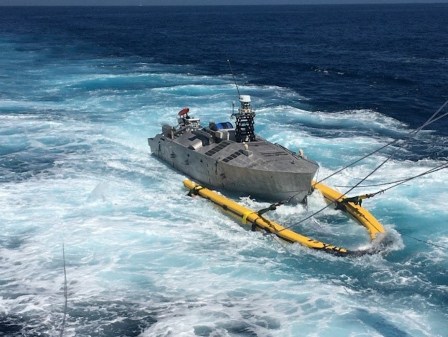USS Charleston’s maiden deployment supported drone flights, mine countermeasure training

The Navy’s Independence-variant littoral combat ship USS Charleston (LCS 18) docked at its homeport in San Diego on June 14 — officially completing its 26-month maiden deployment, which involved multiple “first-time” achievements for the sea service.
Despite some tailing from Chinese vessels, this marked the longest deployment for any U.S. littoral combat ship to date, and it was the first time an LCS performed mine countermeasure training outside of American waters.
Major missions in the 3rd and 7th Fleet areas of operation were conducted during this rotational deployment, including patrolling the East and South China Seas and training for contested maritime resupply tasking.
The Charleston left its berth in California in April 2021 with an embarked MH-60S Knighthawk detachment from Helicopter Sea Combat Squadron 21 and an MQ-8B Fire Scout unmanned aerial vehicle used for search and surveillance activities.
Senior officials who helped lead the deployment confirmed in a press briefing on Wednesday that the helicopter and drone at times conducted simultaneous manned and unmanned flights in support of countermine initiatives at sea.
“The emphasis was showing that we have the mission package and the capability to do [mine countermeasures] and not just inside U.S. waters — but to do it outside U.S. waters in conjunction with other units — and so that was a big step,” Cmdr. Matthew Knuth, the commanding officer of one of the two alternating crews operating the ship, told reporters.
The Charleston and its crew participated in various exercises and joint missions with U.S. and international partners while at sea, including Australia, Japan, France, Sri Lanka, Philippines, Indonesia, Singapore and other nations.
Notably, it was also the first commissioned U.S. Navy ship to enter the port of Manilla in the Philippines since 2019. The United States and the Philippines have recently been moving to enhance U.S. military access to facilities in the area, as both nations are concerned about Chinese activities in the region.
During the call with reporters, Knuth and Capt. Douglas Meagher, who serves as the commodore and commander of LCS Division 11 and Mine Warfare Division 12, also confirmed that the Charleston was embarked with the long-range Naval Strike Missile (NSM) during its deployment.
However, the crew didn’t fire the missile.
“We operated in the East and South China Seas with the NSM aboard,” Knuth noted, adding that in some of those operations the Charleston was followed by Chinese platforms.
“Whether their interest was in LCS (or) the NSM, I can’t tell you,” he said.
“The Charleston performed its mission as required. We were not harassed by near-peer competitors,” he told DefenseScoop in response to questions about the ship’s interactions with Chinese vessels.




